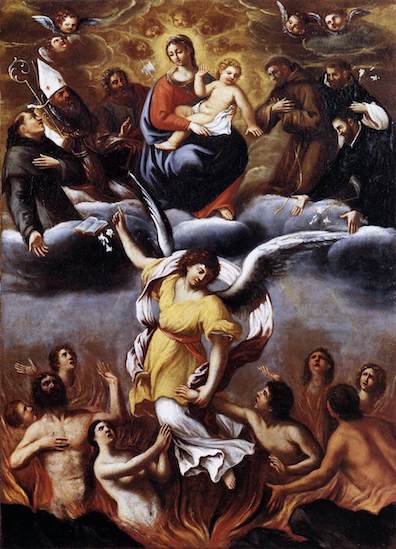The doctrine grew from very old roots. In addition to pagan
texts describing sites of purification in the afterlife, Jews
of the last few centuries BCE said prayers for their dead.
Early Christians adapted these prayers to their mourning
practices, justified by some biblical verses in 2 Maccabees (a
book judged canonical by the Catholic and Orthodox churches):
"And making a gathering, he sent twelve thousand drachmas of
silver to Jerusalem for sacrifice to be offered for the sins
of the dead, thinking well and religiously concerning the
resurrection…. It is therefore a holy and wholesome thought to
pray for the dead, that they may be loosed from sins" (12:43,
46).
The idea that prayers (and money) might help loose sins was
soon joined by the idea that fire could also be effective.
Origen (ca. 185-ca. 253 AD) wrote that "If a man departs this
life with lighter faults, he is condemned to fire which burns
away the lighter materials" (Patrologia Graeca,
13.445). Augustine (354-430 AD) believed it possible that
"some believers shall pass through a kind of purgatorial fire,
and in proportion as they have loved with more or less
devotion the goods that perish, be less or more quickly
delivered from it" (Enchiridion on Faith, Hope, and Love,
69). Augustine distinguished this saving fire from the merely
punitive fires of Hell.
The belief that people who were still burdened with sins
would have to suffer for a time made them something like
penitentiary inmates––doing time for the crime, enduring
rehabilitative punishments, and hoping that good behavior and
strong character witnesses might shorten their sentences. This
conception became much stronger in the High Middle Ages when
theologians began to think of Purgatory not merely as a
condition but as a Third Place adjunct to Hell and Heaven. In
his landmark study The Birth of Purgatory (1984),
Jacques le Goff argued that this development happened in late
12th century Europe in response to the stories of people who
had traveled to places like the Irish island mentioned in Cyclops,
"S. Patrick's Purgatory," which boasted a cavelike
entrance to Purgatory where pilgrims spent the night and
experienced visions. In the early 14th century, Dante's Divine
Comedy solidified the view that Purgatory is a place,
one with benign penitentiary rules, rewards for prayerful
supplications, and (in the last of its seven circles) a wall
of purifying fire.
The Catholic church affirmed the doctrine of Purgatory at the
Second Council of Lyon in 1274, but the Orthodox church
declined to follow suit and 16th century Protestants found the
doctrine a distasteful expansion of scriptural warrant. Hamlet,
written with Protestant audiences (and censors) in mind, does
not use the term Purgatory, but it clearly alludes to it. The
ghost tells the prince that he is "Doomed for a certain term
to walk the night / And for the day confined to fast in fires,
/ Till the foul crimes done in days of nature / Are burnt and
purged away” (1.5.10-13). Having died "With all my
imperfections on my head" (79), he suffers afterlife
punishments so terrifying that even a verbal account of his
"prison-house" would "harrow up thy soul, freeze thy young
blood, / Make thy two eyes like stars start from their
spheres, / Thy knotted and combined locks to part, / And each
particular hair to stand [on] end" (14-19). The unspeakable
tortures of Purgatory, plus the earthly ones caused by
Claudius's poison (these are described in lurid detail), spur
Hamlet to revenge.
Stephen Dedalus seems to be well aware of the play's use of
purgatorial suffering to motivate revenge. His Shakespeare
talk in Scylla and Charybdis, which is centered on the
relationship of ghost and prince, connects the play's
bloodiness to the terrors of the Third Place: "Nine lives are
taken off for his father's one. Our Father who art in
purgatory. Khaki Hamlets don't hesitate to shoot. The
bloodboltered shambles in act five is a forecast of the concentration
camp sung by Mr Swinburne."
In contrast to Shakespeare's suggestion that King Hamlet
might have gone directly to heaven had he been able to confess
his sins, Paddy Dignam's son thinks in Wandering Rocks
that maybe confession has gotten his father into
Purgatory: "That was Mr Dignam, my father. I hope
he’s in purgatory now because he went to confession to
Father Conroy on Saturday night." No doubt Dignam had plenty
of sins to confess, but the fatalism of assuming that
Purgatory is the best he could hope for feels distinctively
Irish. The Catholic church of Joyce's youth drilled the
message of human sinfulness and divine retribution into
parishioners' heads with maniacal harshness, and the magical
folk traditions of the country make ensnarement by the devil
just as likely a possibility as suddenly waking up in
paradise.
Standing at Dignam's grave in Hades, Bloom listens to
the priest's prayer for his soul's deliverance and liltingly
mocks the view that, but for the grace of God, human beings
are destined for an eternity of infernal torture: "We are
praying now for the repose of his soul. Hoping you're well
and not in hell." (In Circe Dignam echoes the
priest's language: "Pray for the repose of his soul.")
Then Bloom thinks of the torture awaiting Dignam even if these
prayers have their intended effect: "Nice change of air. Out
of the fryingpan of life into the fire of purgatory."
Probably only James Joyce would think of applying this
proverbial expression to the Catholic business of saving
souls, but his indoctrination in the view that the deceased
can expect one kind of incineration or another makes it quite
apt. Even for those who receive God's guarantee of eternal
salvation, the church still has a world of pain to inflict.



